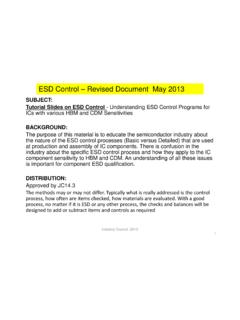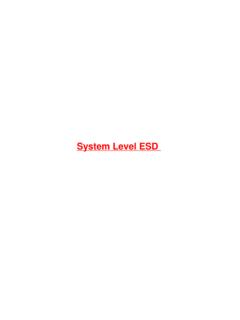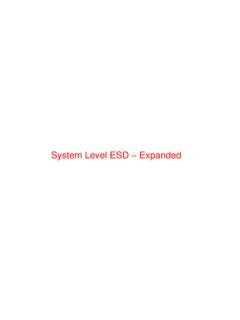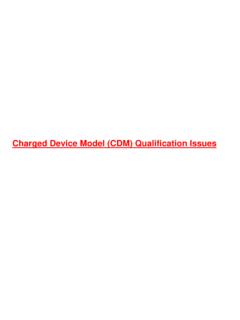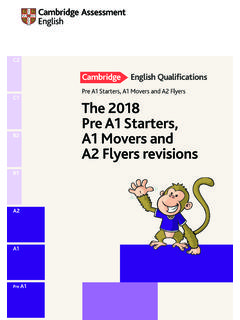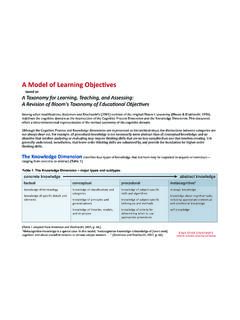Transcription of User Guide of ANSI/ESDA/JEDEC JS-001 Human Body Model ...
1 ESDA/JEDEC JTR001-01-12 User Guide of ANSI/ESDA/JEDEC JS-001 Human Body Model Testing of Integrated Circuits Authors: Joint HBM Working Group ESD Association and JEDEC Solid State Technology Association Electrostatic Discharge Association 7900 Turin Road, Bldg. 3 Rome, NY 13440 JEDEC Solid State Technology Association 3103 North 10th Street Arlington, VA 22201 ESDA/JEDEC JTR001-01-12 Electrostatic Discharge Association (ESDA) standards and publications are designed to serve the public interest by eliminating misunderstandings between manufacturers and purchasers, facilitating the interchangeability and improvement of products and assisting the purchaser in selecting and obtaining the proper product for his particular needs. The existence of such standards and publications shall not in any respect preclude any member or non-member of the Association from manufacturing or selling products not conforming to such standards and publications.
2 Nor shall the fact that a standard or publication that is published by the Association preclude its voluntary use by non-members of the Association whether the document is to be used either domestically or internationally. Recommended standards and publications are adopted by the ESDA in accordance with the ANSI Patent policy. Interpretation of ESDA Standards: The interpretation of standards in-so-far as it may relate to a specific product or manufacturer is a proper matter for the individual company concerned and cannot be undertaken by any person acting for the ESDA. The ESDA Standards Chairman may make comments limited to an explanation or clarification of the technical language or provisions in a standard, but not related to its application to specific products and manufacterers.
3 No other person is authorized to comment on behalf of the ESDA on any ESDA Standard. THE CONTENT OF ESDA S STANDARDS AND PUBLICATIONS ARE PROVIDED AS-IS, AND ESDA MAKES NO REPRESENTATIONS OR WARRANTIES, EXPRESS OR IMPLIED, OF ANY KIND WITH RESPECT TO SUCH CONTENT. ESDA DISCLAIMS ALL REPRESENTATIONS AND WARRANTIES, INCLUDING WITHOUT LIMITATION, WARRANTIES OF MERCHANTABILITY, FITNESS FOR PARTICULAR PURPOSE OR USE, TITLE AND NON-INFRINGEMENT. ESDA STANDARDS AND PUBLICATIONS ARE CONSIDERED TECHNICALLY SOUND AT THE TIME THEY ARE APPROVED FOR PUBLICATION. THEY ARE NOT A SUBSTITUTE FOR A PRODUCT SELLER S OR USER S OWN JUDGEMENT WITH RESPECT TO ANY PARTICULAR PRODUCT DISCUSSED, AND ESDA DOES NOT UNDERTAKE TO GUARANTY THE PERFORMANCE OF ANY INDIVIDUAL MANUFACTURERS PRODUCTS BY VIRTUE OF SUCH STANDARDS OR PUBLICATIONS.
4 THUS, ESDA EXPRESSLY DISLAIMS ANY RESPONSIBILITY FOR DAMAGES ARISING FROM THE USE, APPLICATION, OR RELIANCE BY OTHERS ON THE INFORMATION CONTAINED IN THESE STANDARDS OR PUBLICATIONS. NEITHER ESDA, NOR ITS MEMBERS, OFFICERS, EMPLOYEES OR OTHER REPRESENTATIVES WILL BE LIABLE FOR DAMAGES ARISING OUT OF OR IN CONNECTION WITH THE USE OR MISUSE OF ESDA STANDARDS OR PUBLICATIONS, EVEN IF ADVISED OF THE POSSIBILITY THEROF. THIS IS A COMPREHENSIVE LIMITATION OF LIABILITY THAT APPLIES TO ALL DAMAGES OF ANY KIND, INCLUDING WITHOUT LIMITATION, LOSS OF DATA, INCOME OR PROFIT, LOSS OF OR DAMAGE TO PROPERTY AND CLAIMS OF THIRD PARTIES. Published by: Electrostatic Discharge Association 7900 Turin Road, Bldg. 3 Rome, NY 13440 JEDEC Solid State Technology Association 3103 North 10th Street Arlington, VA 22201 Copyright 2012 by ESD Association and JEDEC Solid State Technology Association All rights reserved No part of this publication may be reproduced in any form, in an electronic retrieval system or otherwise, without the prior written permission of the publisher.
5 Printed in the United States of America CAUTION NOTICE DISCLAIMER OF WARRANTIES DISCLAIMER OF GUARANTY LIMITATION ON ESDA s LIABILITY ESDA/JEDEC JTR001-01-12 i (This foreword is not part of ESDA/JEDEC Joint Technical Report ESDA/JEDEC JTR001-01-12) Foreword The joint ESDA/JEDEC HBM Standard JS-001 -2010 merged the JEDEC HBM Standard, JESD22-A114F, and the ESDA HBM Standard, ANSI/ESD , into a single document. This accomplishment was a significant advance for the industry, since it reduced the confusion and extra effort for maintaining two standards for the same test. However, JS-001 -2010 did not address several important technical issues. To merge the two documents, a number of technical challenges involving the HBM test method, which have emerged over the last several years, were not addressed.
6 The next version of the HBM Standard, JS-001 -2011, began to the address these technical issues. This revision was the most significant update to the HBM test standard in many years and incorporated several new test strategies. This technical report is a user s Guide intended to help those familiar with the traditional HBM test method, as documented in JS-001 -2010, to use the new options available in JS-001 -2011 and in the subsequent 2012 version. The specific changes in the 2012 version are not included in this initial version of the Guide but will be included in the next revision. There are three significant issues that have been addressed in JS-001 -2011: 1. Excessive test time for high pin count devices. 2. Device wear-out due to stressing protection paths hundreds or thousands of times during test, when the path may only be stressed at most a handful of times, if at all, in a real life situation.
7 3. Automated HBM test systems required to test high pin count devices have introduced test system parasitics that potentially can cause unanticipated failure modes not intended by the standard HBM test method. These issues have been addressed with the major changes listed as below ( old refers to JS-001 -2010 and new refers to the specific changes that were implemented in JS-001 -2011). Non-supply pin to non-supply pin testing has been changed to reduce test time. Old: Each non-supply pin was stressed versus all other non-supply pins collectively tied together to terminal B, the ground. This test seldom created failures and has not been required in the Japanese HBM standard, EIAJ ED-4701/304-2, since 2001. New: Non-supply pin to non-supply pin testing is limited to coupled non-supply pin pairs which present a possible weak non-supply pin to non-supply pin combination.
8 Non-supply pin testing to all power supplies (cross domains) has been eliminated to reduce cumulative stress and reduce test time. Old: Each non-supply pin was tested to all power supply groups. New: Each non-supply pin now belongs to or is associated with a supply group that provides current or voltage to the circuitry connected to that pin. Non-supply pins are directly HBM stressed only to those assigned supply groups. Supply to supply testing can be done with a single polarity. Old: For supply to supply testing each supply was tested versus all other supplies with both positive and negative stress. This produced essentially redundant testing in which positive stress of A versus B is very similar to negative stress of B versus A. New: All supply to supply testing may be done with a single polarity, reducing the interaction of the test system parasitics with the device under test (DUT), if the correct polarity is chosen.
9 Two pin testing is now permitted Old: All testing was defined in terms of a single pin being stressed to a group of other pins. This requirement could only be met with relay matrix based test systems, which ESDA/JEDEC JTR001-01-12 ii introduced parasitic capacitances. These capacitances, which appeared even on pins not being stressed, have been shown to introduce false failures on some products. New: All pin combinations may be subdivided into two pin combinations in which a single pin is stressed versus a single current return pin. Two pin testers can be made with minimal parasitic tester capacitance which can reduce the unpredictable interactions between the device under test and the tester parasitics. In addition to the changes discussed above there were several other important changes.
10 4. The section on reporting was modified to accommodate the changes in the pin combinations discussed above. 5. Discussion of current probe specifications and the preference of CT2 over CT1 current probe with regard to the measurement of the HBM decay time. 6. Change in wording for non-supply pins which are shorted together. 7. Changes to the wording on No Connect Pins. 8. Class 0 has been divided into 2 classes. ESDA/JEDEC JTR001-01-12 iii At the time ESD JTR001-01-12 was prepared, the Joint HBM Subcommittee had the following members: Mike Chaine, Co-Chair Micron Technology Terry Welsher, Co-Chair Dangelmayer Associates Timothy Archer STMicroelectronics Robert Ashton ON Semiconductor Andrea Boroni STMicroelectronics Lorenzo Cerati STMicroelectronics Marcel Dekker MASER Engineering Marti Farris Intel Corporation Barry Fernelius MEFAS, Inc.
